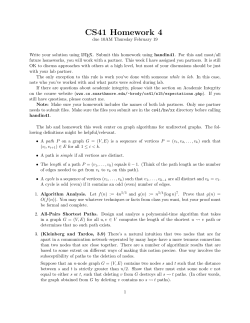
Assignment 4
COMP 531: Advanced Theory of Computation
(Winter 2015)
Assignment 4
Due April 8th
Instructions
Follow these instructions closely.
You will benefit most if you seriously try solving each problem yourself. You may
work with each other but you must write up your own solutions. For each question, you
should clearly acknowledge the people you have worked with.
Clarity and conciseness of your solutions are as important as correctness.
It is important to learn how to write your ideas and solutions clearly and rigorously.
You will lose marks for correct solutions that are poorly explained/presented. When
writing your solutions, assume that your audience is your classmates rather than the
instructor of the course. The high level ideas and an overview of your argument should
be presented before any technical details, and all nontrivial claims have to be proven.
If you do not know how to solve a problem, do not answer it. This will earn you 20%
of the points. Do not make yourself believe in a wrong proof – this is bad for you. And
definitely do not try to sell it! If you don’t know how to solve a problem but you
have some nontrivial ideas, write them down. If you have a solution with gaps, write
your argument and clearly indicate the gaps.
Submit your assignments in class or send a copy to cbades@cs.mcgill.ca before
midnight of the due date.
Questions
1. (10 points) The probabilistic method is a powerful technique to prove the existence
of objects with desired combinatorial properties. The idea is to define a suitable
probability distribution in which the probability of finding the desired properties
is nonzero.
As an illustration of the method, we do the following exercise:
Let G be any graph that has a matching M (a matching is a collection of edges no
two of which intersect each other at any vertex). A subgraph H of G is any graph
whose set of vertices and edges is a subset of the set of vertices and edges of G.
Show that G contains a subgraph H, where H is bipartite and contains at least
1
(|E(G)| + |M |) edges.
2
(Hint: Think of a random bipartition scheme of the set of vertices of G such that
you guarantee that each edge of the matching has its endpoints on opposite edges
of the partition. Calculate the expected number of edges of G that have their
endpoints in opposite partitions.)
2. (10 points) The discrete log problem is: given a prime p and a generator g for
×
the multiplicative group Z×
p , and a point y chosen at random in Zp , find x such
x
that g = y. Establish the following claim. Suppose some deterministic poly-time
algorithm correctly solves the discrete log problem for a 1/ poly(n) fraction of
y ∈ Z×
p (n is the length of the prime p, i.e. the size of the input); then there is a
randomized poly-time algorithm that solves discrete log at all points with high
probability.
3. (10 points) A graph G = (V, E) is called an (n, d, c)-expander if the graph has n
vertices with maximum degree d and satisfies the following property: for every
subset W of V with |W | 6 n/2, W “expands”, i.e. the size of the neighborhood
of W (denoted N (W )) is large, more precisely |N (W ) ∪ W | > (1 + c)|W |. Using
the probabilistic method, one can show that such graphs exist.
We can use√expanders to amplify the correctness of RP algorithms. Let G be a
(2n , 5, (2 − 3)/4)-expander (there is a known construction for that). Use your
n-bits of randomness to pick a random starting point in G. For δ = O(log n), find
all the nodes y1 , y2 , . . . , yk that are within distance δ of your starting node. Run
the RP algorithm k times using the y’s instead of random strings. Prove that this
method will lower the error bound to 1/nc for some constant c.
4. (10 points) You got to your local flee market where you find a vender selling dotproduct machines. A dot product machine has an unknown x ∈ {0, 1}n kept inside
it and an input called z ∈ {0, 1}n . On input z, it outputs the GF2 inner-product
of x and z, i.e. it outputs x1 z1 + x2 z2 + . . . + xn zn mod 2. The size of the machine
is n and there is one for every size. Of course, you want one. But the one you
pick out is too expensive. You beg, you plead, but the vender stands firm. Just
1
as you are about to go, he tells you to wait. From under the counter, he brings
out a machine equipped for the input size you need. The price of this particular
one is reduced by 90%. “Why is this one so cheap?”, you ask. “It’s broken.” he
answers. He goes on to explain that it works fairly well, considering. Obviously
a healthy machine M which computes a linear function must always pass the
following linearity test: M (z1 ) + M (z2 ) = M (z1 + z2 ). The cheap machine is
pretty good, it passes the test 99% of the time over random choices of z1 and z2 .
You can’t resist such a deal – you buy it. Now what?
You wish it worked just as well as a healthy machine. However, it is possible to
use the cheap, defective machine to simulate a healthy one. Furthermore, for each
query to the healthy machine you will only need to make a constant number of
queries to the broken machine as part of the simulation.
The basic experiment is as follows. Since you can’t just believe M when we query
it on z, you calculate M (z) in a roundabout way. We take a self-correcting sample
at z: Pick a random r, output M (z + r) + M (r). (In the case this is not equal to
M (z), the machine is clearly doing something nonlinear.)
(a) Show that for any z, when we take a self-correcting sample at z, the probability
of getting the same value twice is at least .98. (Hint: Show that Pr1 ,r2 [M (z +
r1 ) + M (r2 ) = M (z + r1 + r2 ) = M (r1 ) + M (z + r2 )] > .98.)
(b) Using (a), show that when you take a self-correcting sample at z, you get
the same value at least .96 of the time.
(c) Define M 0 (z) as the value you get at least .96 of the time when you make
a self-correcting sample at z. Show that the M 0 is a function computed by
some healthy dot product machine. (Hint: All you need to show is that M 0
is linear. Fix any z1 and z2 . Argue that Pr [(M (r + z1 ) + M (r) = M 0 (z1 )) ∩
(M (r + z2 ) + M (r) = M 0 (z2 )) ∩ (M (r + z1 ) + M (r + z2 ) = M 0 (z1 + z2 ))] > 0.
Conclude therefore it must be true.)
(d) Show that Pr [M (r) = M 0 (r)] > .94. Show that M 0 is the unique linear
function which is that close to M . (Hint: Show that Pz,r [M (z) = M (z + r) +
M (r) = M 0 (z)] > .94.)
2
© Copyright 2025





















